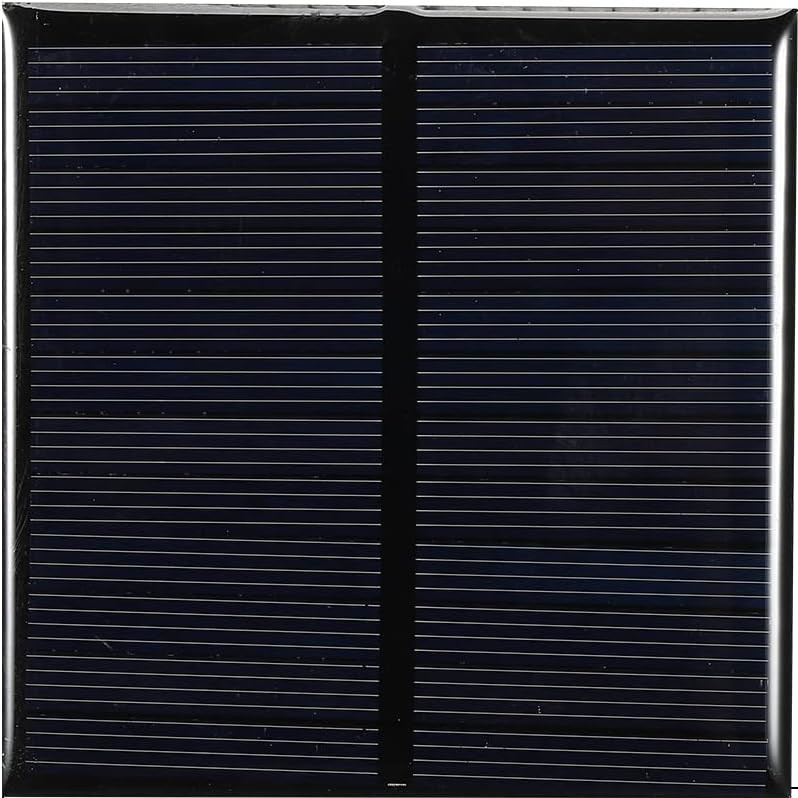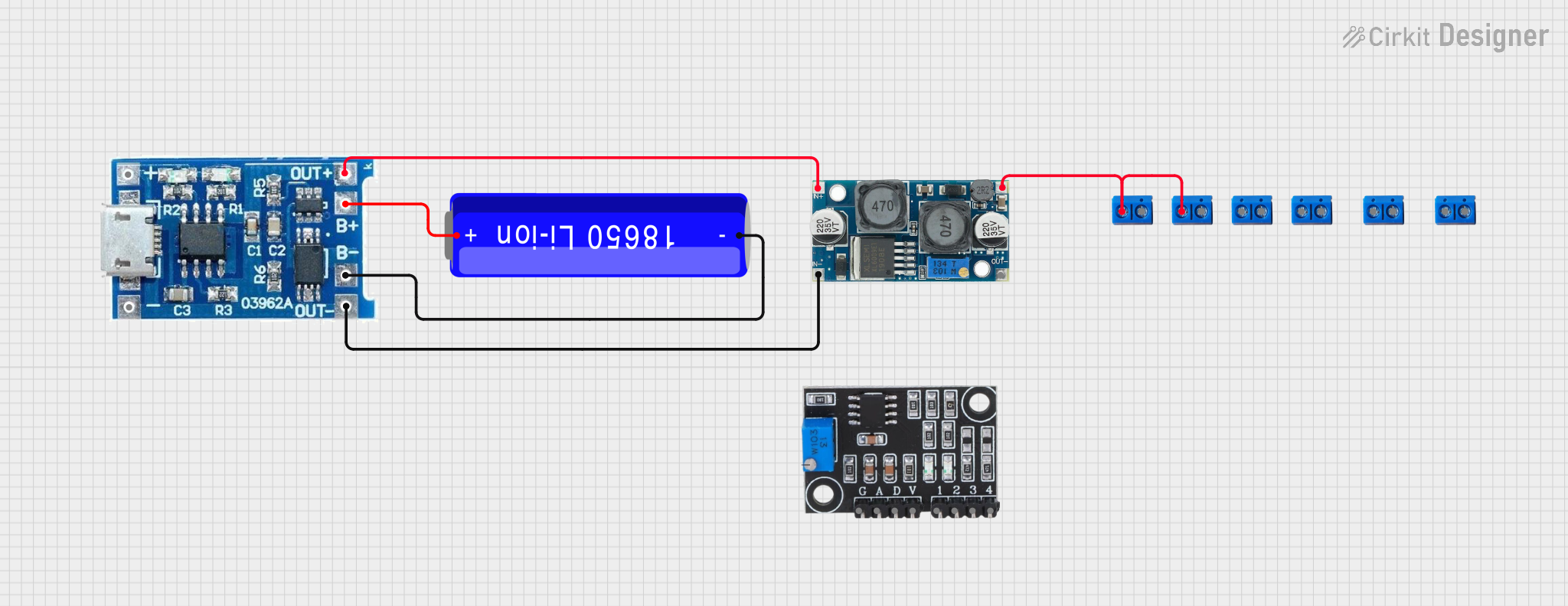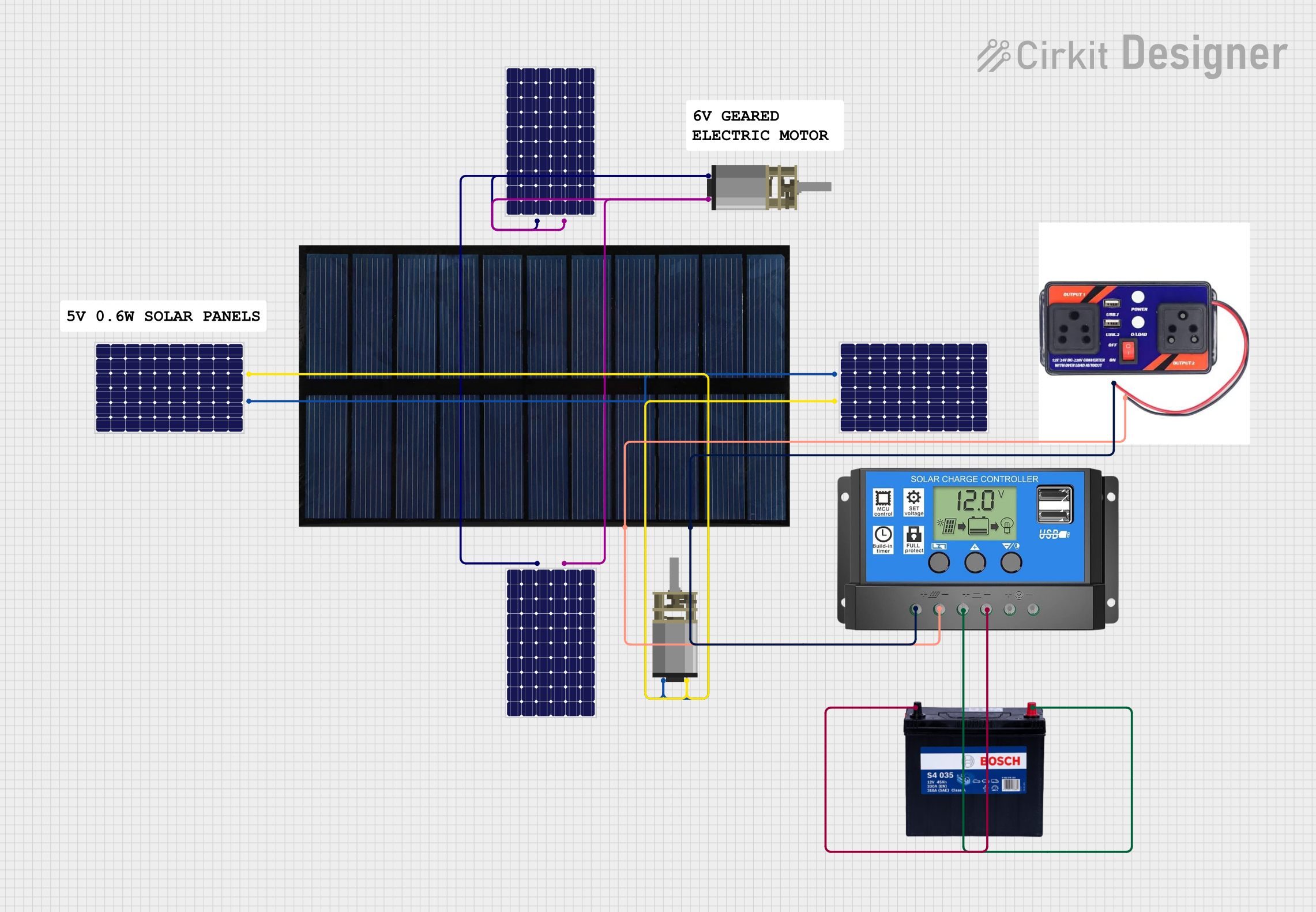
How to Use 80mm x 80mm Solar Panel: Examples, Pinouts, and Specs

 Design with 80mm x 80mm Solar Panel in Cirkit Designer
Design with 80mm x 80mm Solar Panel in Cirkit DesignerIntroduction
The 80mm x 80mm Solar Panel is a compact and efficient photovoltaic module designed to convert sunlight into electrical energy. Its small size makes it ideal for low-power applications, such as powering small electronic devices, charging batteries, or serving as a renewable energy source in DIY projects. This solar panel is lightweight, durable, and easy to integrate into various systems, making it a popular choice for hobbyists and professionals alike.
Explore Projects Built with 80mm x 80mm Solar Panel

 Open Project in Cirkit Designer
Open Project in Cirkit Designer
 Open Project in Cirkit Designer
Open Project in Cirkit Designer
 Open Project in Cirkit Designer
Open Project in Cirkit Designer
 Open Project in Cirkit Designer
Open Project in Cirkit DesignerExplore Projects Built with 80mm x 80mm Solar Panel

 Open Project in Cirkit Designer
Open Project in Cirkit Designer
 Open Project in Cirkit Designer
Open Project in Cirkit Designer
 Open Project in Cirkit Designer
Open Project in Cirkit Designer
 Open Project in Cirkit Designer
Open Project in Cirkit DesignerCommon Applications and Use Cases
- Charging small rechargeable batteries (e.g., AA, AAA, or Li-ion cells)
- Powering low-power devices such as sensors, LED lights, or small fans
- Educational and DIY solar energy projects
- Portable solar-powered gadgets
- Supplementary power source for IoT devices
Technical Specifications
The following table outlines the key technical details of the 80mm x 80mm Solar Panel:
| Parameter | Specification |
|---|---|
| Dimensions | 80mm x 80mm |
| Maximum Power Output | 1.5W |
| Voltage at Maximum Power (Vmp) | 6V |
| Current at Maximum Power (Imp) | 250mA |
| Open Circuit Voltage (Voc) | 7.2V |
| Short Circuit Current (Isc) | 300mA |
| Material | Monocrystalline Silicon |
| Operating Temperature | -20°C to 60°C |
| Weight | ~50g |
Pin Configuration and Descriptions
The solar panel typically has two output terminals for electrical connections:
| Pin Name | Description |
|---|---|
| Positive (+) | The positive terminal for output voltage. Connect this to the positive input of your circuit or battery. |
| Negative (-) | The negative terminal for output voltage. Connect this to the ground or negative input of your circuit or battery. |
Usage Instructions
How to Use the Component in a Circuit
- Positioning the Solar Panel: Place the solar panel in direct sunlight for optimal performance. Ensure there are no obstructions (e.g., shadows or dirt) on the panel surface.
- Connecting to a Load:
- Connect the positive terminal of the solar panel to the positive input of your load or battery.
- Connect the negative terminal to the ground or negative input of your load or battery.
- Using a Voltage Regulator (Optional): If your load requires a specific voltage, use a voltage regulator (e.g., LM7805 for 5V output) to step down or stabilize the voltage.
- Charging a Battery: When charging a battery, use a charge controller to prevent overcharging and ensure safe operation.
Important Considerations and Best Practices
- Sunlight Intensity: The power output depends on the intensity of sunlight. For maximum efficiency, position the panel perpendicular to the sun's rays.
- Avoid Overloading: Ensure the connected load does not exceed the panel's maximum power output (1.5W).
- Use a Blocking Diode: To prevent reverse current flow (e.g., from a battery to the panel at night), connect a blocking diode (e.g., 1N5819) in series with the positive terminal.
- Weather Protection: While the panel is durable, avoid prolonged exposure to extreme weather conditions (e.g., heavy rain or snow) unless it is explicitly rated as waterproof.
Example: Connecting to an Arduino UNO
The 80mm x 80mm Solar Panel can be used to power an Arduino UNO via a rechargeable battery. Below is an example circuit and code:
Circuit Setup
- Connect the solar panel to a 6V rechargeable battery through a charge controller.
- Use the battery's output to power the Arduino UNO via its VIN pin (5V-12V input range).
Arduino Code Example
// Example code to read a sensor powered by the solar panel and display data
// Ensure the solar panel charges a battery to provide stable power to the Arduino
const int sensorPin = A0; // Analog pin connected to the sensor
int sensorValue = 0; // Variable to store the sensor reading
void setup() {
Serial.begin(9600); // Initialize serial communication at 9600 baud
pinMode(sensorPin, INPUT); // Set the sensor pin as input
}
void loop() {
sensorValue = analogRead(sensorPin); // Read the sensor value
Serial.print("Sensor Value: ");
Serial.println(sensorValue); // Print the sensor value to the Serial Monitor
delay(1000); // Wait for 1 second before the next reading
}
Troubleshooting and FAQs
Common Issues and Solutions
Low Power Output:
- Cause: Insufficient sunlight or dirty panel surface.
- Solution: Ensure the panel is in direct sunlight and clean the surface with a soft, damp cloth.
No Output Voltage:
- Cause: Loose or incorrect connections.
- Solution: Check the wiring and ensure the positive and negative terminals are correctly connected.
Overheating:
- Cause: Excessive current draw or exposure to extreme heat.
- Solution: Reduce the load or move the panel to a cooler location.
Battery Not Charging:
- Cause: Faulty charge controller or incorrect wiring.
- Solution: Verify the charge controller connections and ensure it is compatible with the battery.
FAQs
Q1: Can this solar panel power a device directly?
A1: Yes, but only if the device's power requirements are within the panel's output range (6V, 250mA). For devices requiring stable voltage, use a voltage regulator.
Q2: Is the panel waterproof?
A2: The panel is weather-resistant but not fully waterproof. Use additional protection for prolonged outdoor use in harsh conditions.
Q3: Can I connect multiple panels together?
A3: Yes, you can connect panels in series to increase voltage or in parallel to increase current. Ensure the combined output matches your load requirements.
Q4: How do I store the panel when not in use?
A4: Store the panel in a cool, dry place away from direct sunlight to prevent degradation.